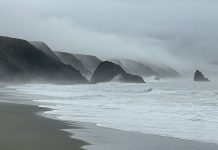Maybe after almost 50 years of Earth Day celebrations and actions we can admit to what EPA Secretary Scott Pruitt and others are trying to tell the rest of us. Pruitt, the former Oklahoma attorney general who is being accused of trying to dismantle his Environmental Protection Agency, says we are overregulated.
Maybe he’s got a point. Just look at all the restrictions, bans, acts and regulations we’ve enacted since the first Earth Day in 1970. No one really could count them all.
After we set the Clean Air Act in 1970 and created the EPA in 1972, we started banning DDT and most other pesticides. Then we launched the Clean Rivers Act and the Marine Mammals Protection Act. Just getting started, we passed the sweeping Endangered Species Act, making it global in 1975 for good measure. We watched Congress put the Clean Drinking Water Act in place in 1975 and we banned lead in our gasoline while we banned styrofoam, chlorofluorocarbons, asbestos and PCBs, too.
We put a “hands off” on most of Alaska and talked 192 nations into joining the Kyoto Protocol on climate change in 1997. That wasn’t good enough so we updated it with the 2015 Paris Accord to target even bigger cuts in carbon dioxide emissions.
No matter who’s counting, that’s a lot of heavy legislation added to the law books and to the EPA regulators’ playbook.
And, that is why we must protest.
We argue here that all those sweeping (overreaching?) regulations could have been summarized in a single act. We could have passed a single Anti-Greed Act and be done with it.
Get rid of rip-offs, conspicuous consumption, corporate avarice, gluttony for power or putting profits over people and we wouldn’t need a “save the whales” campaign or a “safe foods” act.
If it’s not all about greed, why are we killing our oceans or tolerating so much anti-science about global warming? (It is estimated there will be more plastic in our oceans than fish in just 25 short years.)
We forget how many people weren’t yet born in 1970 when the first Earth Day was held. In those days, our Russian River was an open municipal sewer. Sewage treatment back then meant letting the solids settle to the bottom of a “treatment pond” and flushing the rest back into the Laguna or the river — pesticides, phosphates, hormones, minerals and all the rest.
Unchecked erosion and gravel mining were choking out the world-class salmon and steelhead runs. Some of our planet’s richest top soils were ending up in the Pacific Ocean. Sonoma County smokestacks cast carbon dioxide, soot, solvents, methane and other gases into the open air we all breathed.
Back then, if we weren’t poisoning ourselves out of greed, then the only other answer would have been our collective stupidity.
But now we know better, right?
This is also National Parks Week (April 21-29) and you might be surprised to know we only have 58 U.S. national parks, including only four in California (Yosemite, Death Valley, Sequoia and Kings Canyon.) But we also have millions of acres of other public lands and marine sanctuaries such as the Golden Gate National Recreation Area, our state and county parks and many national monuments.
If we knew better, wouldn’t we be dedicating more parks and public lands instead of removing them for strip mining and fracking like our U.S. Interior Department is doing right now?
Why must we still be fighting to protect our California coast from oil drilling?
Whether it’s been too many regulations or not enough really big ones, it’s true either way that we have made great progress in protecting our environment and public health since the first Earth Day.
So now when we hear complaints about overregulating vehicle mileage requirements, carbon gas emissions or fossil fuel extraction rules we know what it’s really about. And it’s no longer because we’re stupid.









